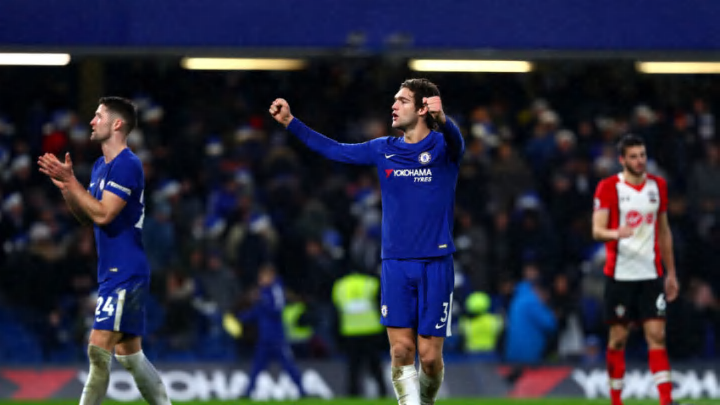Chelsea are approaching their third straight transfer window ostensibly in need of a new left wing-back. For the third straight time, Marcos Alonso is making clear that any new signing will be his backup, not his replacement.
As with last winter and as with last summer, Alex Sandro is at the top of Chelsea’s transfer rumour mill. The Blues have depth and flexibility across the pitch with the exception of left wing-back. Pedro has taken a swing at it, but lacks the defensive skills or positional discipline. Davide Zappacosta had a try, but is far too right-footed to do much besides cut inside through the half-space. Kenedy, well, Kenedy is Kenedy.
Marcos Alonso knows the situation and the rumours. In recent games – as he did last winter and during last season’s run-in – he is telling his teammates not to worry, he can handle it. More importantly, he is telling Alex Sandro “You don’t have to stay home, but you can’t come here.”
Since his fateful entrance in the 75′ against Arsenal in September 2016, he has only sat out two Premier League games – both last season – and one Champions League game. He is Chelsea’s only outfield player to appear in every league game this season, with the most minutes of those players (two whole minutes more than Cesar Azpilicueta).
In the early games of the 3-4-3, Alonso taught the Chelsea world everything they needed to know about left wing-backs. He looked like it was the only position he had ever played and had done so only at top levels. He scored his first goal in his fifth Chelsea start, in the masterpiece theatre against Everton at Stamford Bridge.
Must Read: 10 Chelsea Christmas presents for that special someone
His performances leveled off, and at times flattened, as Chelsea continued their win streak through the holiday season. As Chelsea watchers deepened their understanding of what wing-backs are supposed to do and be, and grew accustomed to his performances, they developed a sense the Blues needed something more. Alonso was serviceable as Antonio Conte’s first left wing-back, but he was not the man Chelsea needed to continue their Premier League run. His 65-minute performance against Tottenham in the streak-ending loss confirmed these perceptions.
With two weeks left in the transfer window, Alonso responded. He scored a brace against Leicester City in the following game, and strung together more top performances. The window closed without a replacement, and he scored his fourth of the season three days later.
A similar pattern played out in the final quarter of the season. Alonso flattened out in mid-spring, was substituted in the loss to Crystal Palace and was on the bench against Manchester United. With the Premier League title all but sewn up, talk shifted to Chelsea’s return to the Champions League. Once again, the Blues’ most pressing need was at left wing-back. Marcos Alonso was good enough for the first year in the 3-4-3, when Antonio Conte’s innovation slayed all comers. But with domestic opponents learning how to defeat the system and European opponents looming ahead, Chelsea would need someone better than Alonso.
Once again, Alonso responded. He finished the season on a strong run, notching his career-best sixth league goal. Chelsea ended the season with the impression they could get away with buying depth or competition at left wing-back, but not necessarily a replacement.
Chelsea spent the summer linked with Alex Sandro, Benjamin Mendy and Danilo as Alonso’s incipient replacement. None arrived, and Alonso returned to his post.
Alonso started this season strongly, scoring a brace against Tottenham in the second week and picking up where he left off. Once Alvaro Morata became a regular and Chelsea switched to the 3-5-2, however, Alonso’s form dipped. Without Eden Hazard in front of him, and without the predictable presence of Gary Cahill behind him on defence, the left wing-back suffered a bit of an identity crisis. With Eden Hazard playing freely in the 3-5-2, Alonso was not as useful connecting the play along the left flank. More of Chelsea’s play went up the right, particularly via Cesar Azpilicueta and Cesc Fabregas.
December brought a return of the Alex Sandro rumours. As he had twice before, Marcos Alonso responded.
Alonso put in a strong game against Newcastle before joining his entire team in the debacle against West Ham. He returned with an assist and a solid game against Huddersfield, and then added to his goal tally during a man of the match performance against Southampton.
Ryan Sessegnon is emerging as a better option for Chelsea than Alex Sandro. He will cost less money, has a longer future ahead of him and could be more amenable to learning from and deputizing Marcos Alonso rather than replacing him. Any new arrival would have to compete with Alonso for the starting XI spot, and Sandro may not be interested in that prospect, let alone what would happen if Alonso wins out.
Next: Tactics and Transfers: Strong January window crucial to Blues' future
Alonso and Gary Cahill both had career-best goal-scoring seasons in 2016/17. They also played together at Bolton in the early stages of their career. They are quickly developing one more thing in common: the ability to respond to all hints of a challenger or replacement with timely performances to show they will stay in Chelsea’s best XI.
